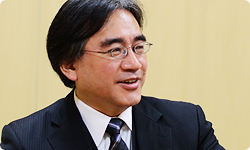Now I understand how you used a different method to update the visuals for The Wind Waker HD. I think it’s an unusual example, but by making it that way, different things came into view.
The way we did it this time, even the designers making the data weren’t able to imagine how it would look when the images first appeared. Because a method had been put in place to completely replace the images, I think there were times when the designers saw those images come up for the first time and they’d be like, “What?!” (to Arimoto-san) Right?
Well, we were like, “Hmm, it’s already done.”
(laughs)
It was a new sensation for something to show up when I had no memory of making it!
Dohta-san’s a bit mischievous, so he’d put in some revisions thinking we’d never notice, and without telling anyone. Then he would wait for someone to notice and say something. As a designer, I couldn’t stand for anyone to think I wasn’t able to see it (laughs), so before Dohta-san revealed it, I wanted to point it out, saying, “Oh, I liked what you put in the other day!” We enjoyed that kind of quiet battle between the two of us.
It’s actually a little pleasing to get caught! (laughs)
The quality improved at amazing speed in the latter half of development. It would change significantly in just half a day!
We were worried at first. Like, “Is this going to work out?”
So of course, people said, “You probably can’t do it in such a short amount of time.” (laughs) Once we got started, a lot popped up.
But like Dohta-san said, with the way we made it this time we couldn’t tell how the final form would shape out in the end, so we just had to believe. The two of us just watched over, wondering how it would change.
Yeah. Like, “We’ve come this far, so what’s wrong?”
He’d say, “No, this is no good at all!”
But you can’t have a waterfall flowing in the wrong direction!
(laughs)
Dohta-san, you never imagined that eleven years later you’d be analysing and reshaping the data of a game you enjoyed before you were a developer.
You can say that again! (laughs)
As someone who experienced it both as a player and a developer, did anything stand out?

In that sense, it felt to me like what they were originally trying to do with The Wind Waker didn’t fit within the confines of SD resolution21. By changing it to HD, I saw how the number of colours increased, the resolution go up, and the animation became finer and fluid, so the character’s eye movement and things like that come alive. It’s something that I realised comparatively as I was working.21. SD resolution: The image quality of analogue television broadcasts before HD televisions.
Before, they were trying to stuff more than would fit into the container. As you were converting the data and programs from that time into the new container, you realised what they had really wanted to do.
Right. That’s exactly what happened.
Upon seeing The Wind Waker HD, I realised that with the original version, we had been trying to make something beyond what Nintendo GameCube could express.
If it looked better than before simply placing it in a new container, then it must have been over-designed for it.
That’s right.
In other words, more energy and creativity was put in than the container could put out.
The reason I pushed so strongly to do it in such a short time without considering a buffer was because the world that we had really wanted to make years ago was unfolding there in the test images Takizawa-san showed me. I’d seen something to make me think, “This is it!” So as a creator, not doing it wasn’t an option.
What’s more, the environment is favourable toward it now.
That’s right.
Um, I love Okinawa and the southern islands (of Japan), so I often go there.
I can tell that from your suntan! (laughs)
(laughs)
I think I was able to make that world convincing because when I made those first test images, I envisioned how good I feel when I’m there.
The comfortable way it feels isn’t something you can derive from a scene in a photograph.
I think Aonuma-san has said this before, about how it’s “reality over realism.” With The Legend of Zelda: The Wind Waker HD, I think we were able to express a good feeling that doesn’t come across by simply portraying a photo-realistic sea or sky.
That includes light or a breeze that the eye can’t see. Of course, it isn’t actually bright and a sea breeze isn’t actually blowing, but you sense those things in that game world. It’s interesting how this game was made based on something that was created eleven years ago, but the way it feels real surpasses the many games out there today with realistic graphics.
Yes, it’s very interesting. It’s a 100% fabricated world – in exact opposition to live-action movies – but it’s natural and feels comfortable. It’s difficult to express why that is.
Maybe it’s because comfortableness itself is stylised.
Ah!
A stylisation of comfort.
The sunlight and the nice breeze are represented in a pleasant way, with anything extra cut out. Only what’s good is left over, so it feels comfortable.

Recently, I’ve been thinking that I want to create images from which you can sense temperature or smells, so I’ve been paying attention to that. When making The Wind Waker HD, I carefully adjusted the lighting and colouring up to the very end.
In this game world, you think, “That sunny spot looks nice and warm,” or “If I go into the shade of that tree, I’ll enjoy a cool breeze.”
The shades really do look cool. You feel like you want to go there! (laughs)
That’s possible because of Wii U. In technological terms, the Wii U can present a wide range of brightness, but that’s a somewhat dull way to describe it! (laughs) When we make Zelda games in the future, I think that will be one important point.
© 2024 Nintendo.